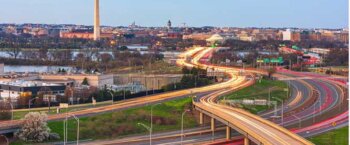7 Steps to Start a Hotshot Trucking Business

There's a better way to find loads.
Demo the Truckstop Load Board and see how easy it is to find the right loads fast.
Find your next load
Make more money starting now.
In 2022, the trucking industry raked in a whopping $940.8 billion in gross freight revenue. If that doesn’t smell like opportunity, what does? While diving headfirst into trucking can seem enticing, hotshot trucking is the perfect way to get into the industry. All you need is a medium-duty truck, some business know-how, and a passion for life on the road. Plus, the startup costs are much lower compared to most owner-operator trucking businesses, making it an excellent option for beginners.
This guide teaches you how to become a hotshot driver and get your business rolling.
What is hotshot trucking?
Hotshot trucking involves moving small, time-sensitive deliveries to a single destination. Large carriers prioritize high volume, while hotshot trucking companies focus on speed and flexibility.
Typically, hotshot drivers are independent contractors using their own vehicles to transport less-than-truckload (LTL) loads like machinery, construction materials, or other freight. They’re used when companies need freight to get to a destination quickly and on short notice. For example, a construction company may “hotshot” an urgent equipment delivery between jobsites when a machine breaks down or there’s a surprise material shortage. Hotshot truckers carry smaller loads like cars, equipment, and partial loads that are too small for standard-size freight haulers.
Hotshot drivers find freight on load boards or through brokers. It’s a great way to make extra cash as an independent owner-operator. Some of the main benefits of starting a hotshot business include:
- Lower startup costs: Instead of creating a traditional owner-operator setup from scratch, hotshot truckers need a much smaller investment to get going. It’s much more accessible for new truckers to invest in a truck and start working.
- High demand: Industries like manufacturing and construction often need quick, reliable deliveries on the fly. Hotshot truckers are always in demand.
- Flexibility: As a hotshot driver, you can work according to your own schedule. Choose the loads that fit your hours, preferences, and capacity. It can be as demanding as you can handle while accommodating the freedom you need.
How to start a hotshot business
Hotshot trucking lets you dip your toes into the trucking industry. If you want more control over your income and hours, here’s how you can start your hotshot trucking career.

1. Get a commercial driver’s license.
If you plan to haul loads under 10,000 pounds, you can usually get by with a standard driver’s license. However, this limits your ability to transport heavier cargo.
As long as you’re not exceeding load restrictions, you can work as a hotshot trucker. But if you want to increase your earnings, look into a commercial driver’s license (CDL). Getting a commercial driver’s license opens you up to more jobs and lets you expand into larger trucks. CDLs range from Class A to Class C, depending on vehicle weight and load type. Be sure to check the requirements for getting a CDL in your state before getting started.
2. Obtain a medical examiner’s certificate (MEC).
Hotshot truck drivers may need a Department of Transportation (DOT) medical card. The Federal Motor Carrier Safety Administration (FMCSA) requires a medical card for truckers operating certain vehicle weights or carrying hazardous materials. A DOT medical examiner assesses commercial truck drivers’ physical, mental, and emotional fitness. If they clear you, you can get started on your trucking business.
3. Establish your business.
You need to set up and register your company before you can start earning income. Here’s how to get your business registered:
- Choose a structure: Decide on the type of business you’re operating. Are you working as a sole proprietorship or a limited liability company (LLC)? Working as an LLC can give truckers some extra tax benefits and personal asset protection if something happens to the business.
- Register your business: Pick your business name. Try to choose something memorable. You’ll avoid infringing on other companies, and it makes it easier for interested parties to find you. Once you’ve settled on a name and structure, it’s time to register your business with your state. Not sure where to start? The Small Business Administration (SBA) offers helpful guidance on the registration process.
- Apply for an employer identification number (EIN): The IRS issues companies an EIN for tax reporting. This number lets you hire employees and start a business bank account. Opening a company account to separate your business and personal finances is a good idea. An EIN allows you to pay yourself and other employees wages and contribute more to your 401(k) than you can as an individual.

4. Find proper insurance
Insurance is your safety net against liability while you’re trucking. It protects you while on the road, but it’s also required by the FMCSA. There are different types of insurance based on your vehicle, business, and needs. Your insurance coverage should include:
- Primary liability insurance: This protects you if you’re at fault in an accident. It covers personal and property damage.
- Cargo insurance: Cargo insurance covers the goods you transport in case they’re damaged, stolen, or lost.
- Physical damage insurance: Keep your truck and trailer safe from accidents and theft that may affect their condition.
- Non-trucking liability (NTL) insurance: NTL insurance covers you when you’re using your truck for nonbusiness purposes.
5. Get your operating authority
Previously, if you planned to haul loads across state lines, you needed a motor carrier (MC) authority number from the FMCSA. However, the FMCSA is updating its registration system, and part of that update involves getting rid of MC numbers. Instead, you’ll have one USDOT number with a suffix explaining authority type. You can apply by completing online forms, paying registration fees of $300 per form, and submitting insurance proof.
Getting your operating authority involves a lot of paperwork. You could also “lease” your vehicle to a carrier and operate under their authority. Most companies charge for this service, but it is an easier way to go. Either way, you will need a DOT number to operate your business.
6. Purchase the right equipment
To start hauling loads, you’ll need a truck and trailer. Think about whether buying or leasing makes more sense for your situation. Do you have the funds to purchase your truck and trailer outright? Would you rather lease your equipment? Owning gives you more control, but it means higher upfront expenses. Leasing means lower upfront costs, but there are more restrictions since you don’t own the equipment.
Once you know whether you want to rent or own your equipment, it’s time to decide what truck and trailer you’re getting. There are lots of options out there, each with different load-handling capabilities. You’ll usually want a medium-sized truck. Vehicles larger than pickup trucks will haul decent-sized loads, making them perfect for a hotshot business. There are three medium-duty classes classified by gross vehicle weight rating (GVWR):
- Class 3: Vehicles in this class have a GVWR of 10,001 to 14,000 pounds, suiting lighter hotshot loads.
- Class 4: These heavier, noncommercial trucks have a 14,001- to 16,000-pound GVWR.
- Class 5: Classified as light commercial trucks, Class 5 vehicles have a GVWR of 16,001 to 19,500 pounds.
You can also use trailers to expand your load-carrying capacity:
- Bumper pull trailers: These cost-effective and easy-to-use trailers are popular with civilian drivers. They suit smaller loads.
- Gooseneck trailers: Goosenecks can carry heavier loads. They have a tighter turn radius than bumper pull trailers.
- Tilt deck trailers: These trailers tilt at an angle for easier heavy cargo loading.
- Lowboy trailers: A low center of gravity makes lowboys ideal for the heaviest loads.
- Dovetail trailers: Since they sit low to the ground, dovetails suit hauling cars or other equipment with wheels.
7. Manage your finances
Like any job, you need to make money to be successful. Hotshot trucking relies on finding profitable loads without over-extending your expenses. The key number you need to figure out is your rate per mile (RPM) — the sweet spot between expenses and making money. Your RPM is a combination of your expenses, the market, and what competitors are charging. Your expenses are costs like insurance, fuel, maintenance, and taxes. You need to set a rate that covers these costs and makes a profit.
Trucking isn’t all open roads and setting your own hours. Being a hotshot trucker means managing your own finances. Use a reputable bookkeeper or solid accounting software to balance your finances. You have to track every dollar and account for changing fuel costs, unexpected maintenance, and tax planning — to keep your business afloat. Use a load board to avoid load with unprofitable rates, and to choose reliable brokers with excellent payment records to pay you on time and keep your finances stable.
Factoring is another critical part of managing hotshot trucking finances. It’s common to see pay delays in the trucking industry. Carriers get paid once customers pay their invoices and this could take weeks. Instead of dealing with cash flow issues, hotshot truckers can use factoring tools to get paid for a hauled load much faster. This keeps your cash flow in good shape so you can pay your expenses and keep your truck on the road.
Finding loads and growing your business
Once you have your truck, documents, and finances in order, it’s time to start taking on jobs. Finding quality hotshot loads is about more than making a quick buck. You need to build a business that can make you profitable. Here’s how to do it.
Use load boards
Load boards are the best way to find quality loads from reliable and qualified sources. With the Truckstop Load Board, you get unlimited searches, the ability to post your truck, and even instant booking to keep things moving fast. Instead of waiting around for loads to fall in your lap, you can use load boards to find loads when you need them.
When searching for loads with load boards, make sure you’re strategizing. Don’t just take any load. You need to make a profit. You can use the search filters to narrow results by location, rate, or weight to find jobs that work for you. Also, make sure to check broker ratings. Load boards have broker ratings next to the loads, letting you avoid shady brokers and bad deals.
Network with brokers and shippers
Building relationships with brokers and shippers is another essential part of expanding your trucking business. Load boards are a great way to connect you to loads and establish industry connections that give you consistency. Work toward regular freight opportunities by getting the word out there about your work ethic. Brokers and shippers want to work with carriers who are on time, professional, and reliable. Make sure to check with the same brokers and shippers about future loads. If you reach out to them and book more loads that you haul successfully, they’re more likely to use you again.
Build a client base
The better you perform, the more you build your reputation. Be dependable and communicative with brokers and shippers. Load boards can help with this by providing real-time tracking updates for better communication. When brokers and shippers see that you’re transparent and reliable, they want to be your clients.
Additionally, try to offer competitive pricing. Use the load board to understand market rates. You can offer better prices than the competition’s without undercutting yourself. This strategy makes you a more desirable carrier while still turning a profit. Shippers and brokers will keep partnering with you once you prove yourself.
Become a trucking hotshot with Truckstop
Truckstop empowers hotshot trucking companies with innovative tools to boost efficiency and success. Our Truckstop Factoring service gets you paid within 24 hours of invoice verification. For load searches on the move, Truckstop Go™ brings you the power of our load board to the palm of your hand.
Discover how we can take your hotshot trucking business to new heights. Request a free load board demo today!

Get helpful content delivered to your inbox.
Sign up today.
Find high-quality loads fast, get higher rates on every haul, and access tools that make your job easier at every turn.






